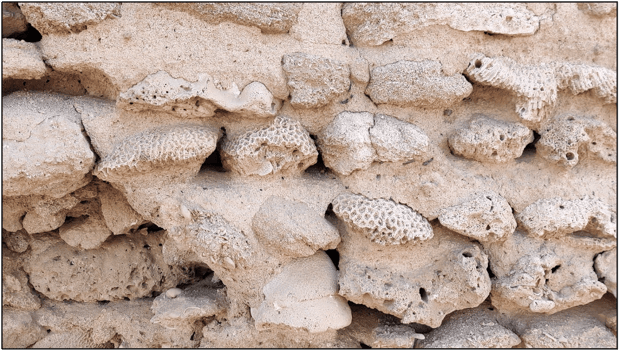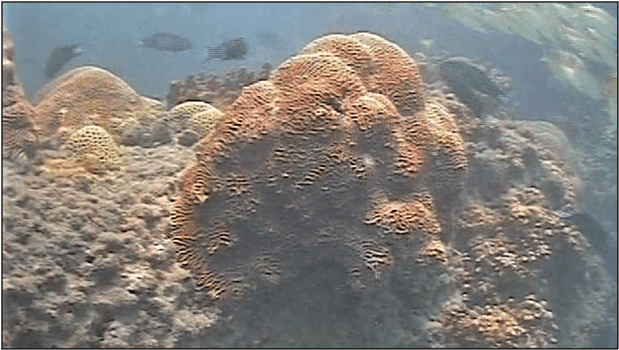The Curious Case of Corals in Ras Al Khaimah
The story of the people of Ras Al Khaimah is interwoven with the story of the sea. From fishing to pearling, seafaring, and trading, coastal resources were- and still are- a backbone of local life and culture. In fact, the sovereign family of Ras Al Khaimah, the Al Qasimi, were known for their seafaring; leading strong defensives against British forces throughout the 1800’s. During the 15th century, the renowned navigator and cartographer Ahmad ibn Majid hailed from what is now Ras Al Khaimah. He is still affectionately regarded as the “Lion of the Sea.”
Surprising to some, one way to explore this enduring connection to the sea is by observing the local architecture. A walk through the breezy Al Jazirah Al Hamra Heritage Village, which hosts Ras Al Khaimah’s annual Fine Arts Festival, brings visitors face to face with a peculiar building material: coral. At least as far back as the 1500’s, hard corals were harvested from local coral reefs to build homes, mosques, and courtyards. In 2017, Dr. John Burt and Noura Al Mansoori of NYUAD conducted a citizen-science project with volunteers from Emirates Natural History Group where they documented around 2,000 of the over 11 million individual corals at the site and identified 11 distinct genera.1 Today, the colorful living descendants of these corals are found throughout Ras Al Khaimah and visitors can catch a glimpse of them by snorkeling along any of the numerous breakwaters which have become unplanned artificial reefs or by scuba diving at some of the emirate’s many shipwrecks. For coral connoisseurs, Ras Al Khaimah’s northernmost shipwreck near the border with Oman offers an easily accessible and exceptional look into the mysterious world of deep-water soft corals.

Image 1- Coral stones in the wall of a structure in the Al Jazirah Al Hamra Heritage Village in Ras Al Khaimah.[Image courtesy of the Ahmad ibn Majid Project]
Like many coral reefs across the world, the size of Ras Al Khaimah’s natural coral reefs have been greatly reduced due to anthropogenic causes like coastal development and climate change. This is adverse since coral reef ecosystem services include conserving biodiversity, nursing commercially important fish populations, coastal storm and erosion protection, medicinal developments, supporting healthy lifestyles, and tourism. While coral themselves do not sequester carbon, the marine conditions they create strengthen the communities that do, like oysters, seagrasses, and mangroves.2-6 Globally, coral reef ecosystems and the services they provide are valued from tens of billions USD to over 300 billion USD annually depending on the criteria assessed.3, 7-10 Along coral reef coastlines, studies have shown that reefs reduce damages from storms by more than 4 billion USD annually.9 The global value attributed to coral reef tourism is around 36 billion USD annually.10
The 2016 journal publication by Raymond Grizzle, Krystin Ward, Rashid AlShihi, and John Burt entitled, Current Status of Coral Reefs in the United Arab Emirates: Distribution, Extent, and Community Structure with Implications for Management, compared the characteristics of 23 known major coral reefs across the UAE. They found that one coral reef in the northern region of Ras Al Khaimah harbored the highest coral diversity in the country and the second highest living coral cover percentage.11 Additionally, ongoing monitoring by Ras Al Khaimah’s Ahmad ibn Majid Project has observed an aversion to coral bleaching at that site during widespread bleaching events. As recently as August 2021, coral at this site showed little to no bleaching during an event where reefs in other emirates, including Abu Dhabi and Fujairah, reported extremely high rates of bleaching with mortality rates of up to 100% in 5 meters of water depth.

Image 2- Hard corals growing on a breakwater in Ras Al Khaimah. Though this photograph was taken shortly after a widespread bleaching event in August 2021, the coral at this site appeared healthy. [Image courtesy of the Ahmad ibn Majid Project]
With the most diverse coral community in the UAE and with some merit of natural protection against coral bleaching, this unique reef in Ras Al Khaimah is now a critical resource for safeguarding coral species that are approaching their survival thresholds in other emirates and for protecting some coral species in Ras Al Khaimah from local functional extinction. Since the Arabian Gulf is an extreme marine environment in terms of temperature and salinity, it is expected that research at sites like this one can have a significant global impact on coral conservation efforts by helping us understand how coral in other regions may respond to anticipated environmental changes like sea temperature rise, amongst other topics. Researchers in the UAE have advocated for protection status for this site since at least 2008.
As episodic stressors driven by climate change become more common and direct stressors from coastal developments continue to encroach on natural spaces, the protection of corals and the strategic use of shared coastal resources in Ras Al Khaimah grows increasingly urgent. Fortuitously, Ras Al Khaimah’s ambitious pursuit to grow tourism presents a long-awaited opportunity to build evidence-based environmental management into the foundation of new economic growth.
Ras Al Khaimah aims to become the regional leader in Sustainable Tourism by 2025;12 a goal which government entities and industry leaders from across the emirate have committed to. Embracing the modern ethos of responsible consumerism and targeting millennial demographics, the sustainable tourism strategy for the emirate highlights its extraordinary natural features like beaches, wadis, mangrove forests, coastal wetlands, deserts, and mountains, and seeks to establish a distinct portfolio of adventure tourism activities tailored to these attributes. For Ras Al Khaimah to cultivate the meaningful environmental and cultural experiences that modern visitors demand: not only must its natural resources exist, but they must thrive and continue to prosper for future generations. Consequently, integrating economic and environmental priorities, protecting and rehabilitating natural resources, utilizing nature-based solutions, and achieving UN Sustainable Development Goals shall become integral and highly scrutinized parts of Ras Al Khaimah’s “Sustainable Destination” credibility. As regional competition grows, the magnifying glass on Ras Al Khaimah’s environmental policies will too.
To the coral, fish, birds, turtles, dolphins, lizards and other wildlife in Ras Al Khaimah, this spotlight on accountability is an asset. As species of environmental, economic, and historical significance, the curious case of corals in Ras Al Khaimah embodies the growing consciousness that environmental conservation is not only of environmental importance. Environmental conservation is cultural recognition, economic resilience, food security, public health, and educational opportunity.
References
- Zacharias, A., 2018. Maritime history found in the coral walls of RAK ghost town. The National, [online] Available at: <https://www.thenationalnews.com/uae/maritime-history-found-in-the-coral-walls-of-rak-ghost-town-1.731436> [Accessed 17 May 2022].
- Spalding, M. D., Ruffo, S., et al. (2014). The role of ecosystems in coastal protection: Adapting to climate change and coastal hazards. Ocean & Coastal Management, 90, 50–57. https://doi.org/10.1016/j.ocecoaman.2013.09.007
- Narayan, S., Beck, M. W., et al. (2016). The Effectiveness, Costs and Coastal Protection Benefits of Natural and Nature-Based Defences. PLOS ONE, 11(5), e0154735. https://doi.org/10.1371/journal.pone.0154735
- Guerra-Vargas, L. A., Gillis, L. G., et al. (2020). Stronger together: Do coral reefs enhance seagrass meadows “blue carbon” potential? Frontiers in Marine Science, 7. https://doi.org/10.3389/fmars.2020.00628
- Guannel G, Arkema K, et al. (2016) The Power of Three: Coral Reefs, Seagrasses and Mangroves Protect Coastal Regions and Increase Their Resilience. PLoS ONE 11(7):e0158094. doi:10.1371/journal.pone.0158094
- Shaver EC, Silliman BR. 2017. Time to cash in on positive interactions for coral restoration. PeerJ 5:e3499 https://doi.org/10.7717/peerj.3499
- UN Environment, ISU, ICRI and Trucost 2018. The Coral Reef Economy: The Business Case For Investment in the Protection, Preservation and Enhancement of Coral Reef Health. 36pp
- Cooper, E. L., Hirabayashi, K., et al. (2014). Corals and Their Potential Applications to Integrative Medicine. Evidence-Based Complementary and Alternative Medicine, 2014,1–9. https://doi.org/10.1155/2014/184959
- Beck, M. W., Losada, I. J., et al. (2018). The global flood protection savings provided by coral reefs. Nature Communications, 9(1). https://doi.org/10.1038/s41467-018-04568-z
- Spalding, M., Burke, L., et al . (2017). Mapping the global value and distribution of coral reef tourism. Marine Policy, 82,104–113. https://doi.org/10.1016/j.marpol.2017.05.014
- Grizzle, R., Ward, K., Al Shihi, R., & Burt, J. (2016). Current Status of Coral Reefs in the United Arab Emirates: Distribution, Extent, and Community Structure with Implications for Management. Marine Pollution Bulletin, 105 (2), 515-523. doi:10.1016/j.marpolbul.2015.10.005
- Dayanand, N., 2022. ATM 2022: Ras Al Khaimah’s going gung ho about ‘adventure tourism’. Gulf News, [online] Available at: <https://gulfnews.com/business/tourism/atm-2022-ras-al-khaimahs-going-gung-ho-about-adventure-tourism-1.87737137> [Accessed 17 May 2022].

